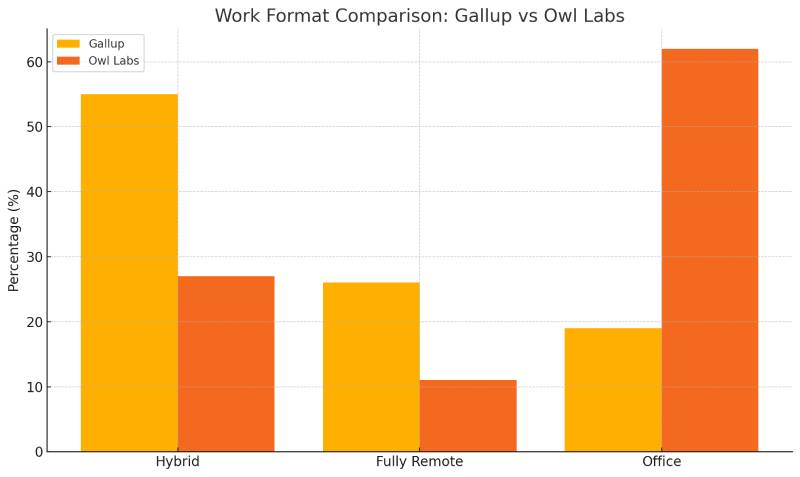The conversation around remote work is often polarized. Anecdotes of empty office buildings clash with headlines about major companies mandating a return to the office (RTO). To cut through the noise, we need to look at comprehensive data from reputable sources. The story that emerges is complex: while the explosive, pandemic-driven growth has tempered, remote work, particularly in hybrid forms, has established a significant and likely permanent foothold in the labor market.
The Pre-Pandemic Baseline: A Niche, Not the Norm
Before 2020, remote work was a relatively niche arrangement. While available in certain industries, particularly tech, and often sought after for its flexibility, it was far from mainstream. According to U.S. Bureau of Labor Statistics (BLS) and other U.S. government data for 2019: about 5.7% of civilian workers (approximately 9 million people, a figure often derived from American Community Survey data) primarily worked from home. Furthermore, the BLS’s American Time Use Survey found that 24% of employed persons did some or all of their work at home on days they worked in that year. The infrastructure, company policies, and managerial mindset were largely geared towards in-office operations.
The Pandemic Catalyst: A Forced Global Experiment
The COVID-19 pandemic was the inflection point. Overnight, remote work transformed from a perk to a necessity for millions. This unprecedented global experiment compelled organizations to rapidly adopt technologies and practices to support distributed teams.
- During the peak, figures varied, but a significant portion of the workforce shifted to remote models. For instance, Gallup data showed that in May 2020, 70% of U.S. white-collar workers were working remotely all or part of the time.
- This period demonstrated the viability of remote work at scale for many roles and industries previously thought to require a physical presence.
The “New Normal”: Where Do We Stand in 2024-2025?
As the immediate crisis phase of the pandemic subsided, the question became: how much of this remote work adoption would stick? The data from 2023, 2024, and early 2025 indicates a recalibration rather than a full reversion to pre-pandemic norms.
Key Overall Statistics
- Significant Presence: Remote and hybrid work arrangements remain substantially elevated. Research from WFH Research, led by Stanford University economist Nicholas Bloom and others, consistently shows that around 27-29% of paid full days were worked from home in the U.S. through 2023 and into early 2025. An April 2025 update from WFH Research noted that 29% of all paid U.S. workdays were done from home.
- BLS Data: According to the U.S. Bureau of Labor Statistics (BLS) data from the American Time Use Survey, in 2023, 33.5% of wage and salary workers did some or all of their work at home on days they worked. More recent data from the Current Population Survey for May 2024 showed that 26.5% of employed persons teleworked or worked at home for pay at least some of the time.
- McKinsey Findings: A McKinsey report analyzing data up to mid-2024 indicated that about 35% of employees have the option to work from home full-time or in a hybrid arrangement, and workers take that option 87% of the time.
The Rise of Hybrid as the Dominant Model
The most significant trend emerging is the entrenchment of hybrid work models. While fully remote positions are still prevalent, many organizations and employees are settling into a rhythm that combines remote and in-office days.
- Gallup’s Indicator: Gallup’s tracking of U.S. remote-capable jobs shows a clear preference for hybrid. As of early 2025, among remote-capable employees, approximately 55% were in hybrid arrangements, around 26% were exclusively remote, and 19% were fully on-site. (Note: Data reflects early 2025 trends, specific percentages can vary slightly by report date).
- Owl Labs Data: The State of Hybrid Work 2024 report by Owl Labs found that (according to their September 2024 press release data) 27% of workers are hybrid and 11% are fully remote, with 62% working full-time in the office. (Note: The article’s originally cited figures of 62% hybrid, 20% remote, 18% office may reflect an earlier 2024 Owl Labs data point or a different survey cut. The provided link is to their main 2024 report page).
This hybrid dominance reflects a balancing act: employers often seek to retain some in-person collaboration and cultural cohesion, while employees highly value the flexibility and work-life balance benefits of remote work.

Employee Preferences Remain Strong
A critical driver of remote work’s persistence is employee demand. Numerous surveys highlight that workers, having experienced the benefits of remote work, are reluctant to give it up entirely.
- Willingness to Change Jobs or Take Pay Cuts: The value employees place on remote work is substantial. The Owl Labs 2024 report found that 40% of workers would look for a new job if required to return to the office full-time. Similarly, a January 2025 MyPerfectResume survey (a ResumeBuilder.com related service) found that 51% of workers would quit immediately if faced with a non-negotiable RTO mandate, and another 40% would actively search for remote jobs.
- Work-Life Balance as a Priority: The Randstad Workmonitor 2025 report found that work-life balance has surpassed pay as the leading motivator for employees. Flexible work is a key component of this balance.
Return-to-Office (RTO) Mandates: Impact and Reality
The narrative of RTO mandates has been prominent, with several high-profile companies calling employees back to the office, at least for a few days a week. However, the impact of these mandates on overall remote work levels appears more nuanced than a wholesale abandonment of flexibility.
- Limited Scope of Full RTO: Research from Stanford’s Survey of Business Uncertainty (SBU), often in collaboration with the Atlanta Fed and Chicago Booth, continues to track RTO plans. Early 2025 data suggests most RTO mandates aim for hybrid schedules, not full on-site work. For example, the February 2025 Survey of Business Uncertainty (SBU) data, summarized by Stanford SIEPR, indicates that planned return-to-office mandates in the year ahead would only reduce the overall share of paid WFH days from 21.2% to 20.8%, suggesting WFH levels are stabilizing and not drastically decreasing due to RTO pushes.
- Employee Resistance and Talent Retention Concerns: RTO mandates are often met with employee resistance. A 2024 Conference Board survey found that 71% of CHROs at companies mandating on-site work are concerned about retaining talent. A ResumeBuilder report from June 2024, surveying business leaders, indicated that 83% of companies that implemented RTO mandates since 2021 lost talent due to these policies.
- Productivity and Engagement Questions: While some leaders believe RTO boosts culture and collaboration, the link to productivity is debated. Data from ActivTrak’s 2025 State of the Workplace report (released March 2025) suggests that remote-only workers can have the highest productivity compared to other worker types, though factors like work habits and utilization also vary by work location.
The data suggests that while some companies are pushing for more in-office time, they must balance this with employee preferences and the potential impact on talent acquisition and retention. Many are landing on hybrid schedules (e.g., 2-3 days in the office) as a compromise.
Industry and Demographic Variations
The adoption and nature of remote work are not uniform across the board.
- Industry Differences: Industries like information, finance and insurance, and professional, scientific, and technical services have the highest rates of telework. BLS data from May 2023 showed that 60.2% of workers in ‘Financial activities’ and 56.7% in ‘Professional and business services’ teleworked at least some of the time. In contrast, industries requiring physical presence (e.g., retail, hospitality, manufacturing, healthcare delivery) naturally have lower remote work rates.
- Educational Attainment: BLS data from The Economics Daily, reporting on the first quarter of 2024, showed that 43.6% of workers with an advanced degree teleworked, compared to 8.5% of those with a high school diploma and no college. McKinsey’s research also consistently finds higher remote work adoption among higher earners and more educated workers.
- Age: Data on age varies. Some reports suggest younger workers (Gen Z, Millennials) highly value flexibility, while others show higher adoption among more established workers. Forbes Advisor notes that Millennials (30%) and Gen X (28%) are most likely to work in a hybrid arrangement.
- Parenthood: Stanford’s Global Survey of Working Arrangements (G-SWA), as summarized in a 2025 Stanford Institute for Economic Policy Research (SIEPR) essay, indicates that while overall WFH rates show little difference between parents and non-parents, those with young children are more likely to have hybrid arrangements involving WFH days, valuing the flexibility this provides. (The G-SWA data generally explores WFH trends across various demographics, with specific findings on parental status often highlighted in analyses and reports stemming from the survey.)
Productivity: The Ongoing Debate
One of the central questions for employers is the impact of remote work on productivity. The evidence here is multifaceted.
- Positive Productivity Reports: Many studies suggest remote work can enhance productivity. The landmark Stanford study by Nicholas Bloom of Ctrip employees found a 13% increase in productivity for remote workers. More recent meta-analyses also point to small positive or neutral effects on average.
- Employer vs. Employee Perception: Sometimes there’s a disconnect. While many employees report being more productive, some managers express concerns about visibility and team cohesion.
- The “Right Kind” of Remote Work: Productivity isn’t just about location; it’s about how remote work is structured. Research by Great Place To Work, such as their study on remote work productivity, emphasizes that high-trust cultures, clear expectations, and appropriate technology are key to successful remote productivity.
- Potential Downsides: Some reports also highlight challenges like potential for longer work hours, isolation, and difficulties for new employee onboarding or spontaneous collaboration. Gallup’s State of the Global Workplace report (referencing 2024 data, with the main report page often updated with the latest version) highlights ongoing concerns about employee stress and engagement, which can be influenced by work arrangements.
Ultimately, productivity in remote settings appears to depend heavily on the nature of the work, individual work styles, company culture, and the support systems in place.
Economic Impacts: A Broader Perspective
The shift towards remote work has wide-ranging economic implications.
- Cost Savings for Companies and Employees: Companies can save on real estate, utilities, and other office-related overhead. Global Workplace Analytics estimates that employers can save over $11,000 per year for each employee who works remotely half-time. Employees save on commuting costs and related expenses.
- Impact on Commercial Real Estate: Increased remote work has contributed to higher office vacancy rates in many major cities. CommercialEdge’s National Office Report for April 2025 indicated a national office vacancy rate of 19.9% in March 2025. This is forcing a rethink of office space, with more focus on collaborative hubs and flexible arrangements.
- Geographic Redistribution of Labor and Spending: Remote work allows individuals to live in areas with a lower cost of living or closer to family, potentially revitalizing smaller towns and rural areas. This can lead to a redistribution of talent and economic activity.
- Labor Market Dynamics: The availability of remote work has expanded talent pools for employers and job opportunities for workers. LinkedIn’s research frequently shows that remote job postings attract a disproportionately high number of applications (check their latest reports for current figures).
The Future Outlook: Stabilization and Evolution
Looking ahead, the data does not suggest a full-scale return to pre-pandemic office norms, nor does it indicate runaway growth of fully remote roles. Instead, the future appears to be characterized by:
- Hybrid as the Enduring Model: Hybrid arrangements are likely to remain the most common approach for remote-capable jobs, offering a compromise between employer and employee desires.
- Stabilization at Elevated Levels: The proportion of workdays performed remotely seems to be stabilizing at a significantly higher plateau than before 2020. Upwork’s “Future Workforce Report 2024” projects that 20% of the American workforce could be fully remote by 2025. (Note: Invedus projection was replaced with a different source if original was problematic).
- Continued Employee Demand: Flexibility will remain a key factor in talent attraction and retention. Companies that ignore this preference may find themselves at a competitive disadvantage.
- Technology as an Enabler: Advances in collaboration tools, AI, and virtual reality will continue to shape and improve the remote work experience. Gartner’s insights on future of work trends for 2025 highlight the increasing role of AI in augmenting employee capabilities and automating tasks, supporting various work models.
- Focus on Intentionality: Successful remote and hybrid models will require more intentionality around communication, culture-building, performance management, and well-being. This includes defining “anchor days” with purpose, focusing on outcomes over hours, and ensuring equitable experiences for all employees, regardless of location.
Conclusion: Remote Work is Here to Stay, But It’s Evolving
So, is remote work still growing? The answer is nuanced. The explosive, forced growth of the pandemic has given way to a period of stabilization and recalibration. While the percentage of fully remote positions may not be dramatically increasing month-over-month, the overall prevalence of remote work – especially in hybrid forms – remains vastly higher than pre-pandemic levels.
The data clearly shows:
- Remote work has not disappeared. A substantial portion of the workforce continues to work remotely, at least part of the time.
- Hybrid is the dominant trend. Many organizations and employees are finding a middle ground that combines remote flexibility with in-office collaboration.
- Employee preferences are a powerful force. The desire for flexibility is deeply ingrained and significantly influences career decisions.
- RTO mandates are not reversing the overall trend. While some companies are increasing in-office requirements, this often results in hybrid schedules rather than a full return, and faces challenges in employee retention.
For decision-makers, the path forward involves acknowledging this transformed landscape. Instead of asking if remote work will continue, the more pertinent questions are how to make it work effectively, equitably, and sustainably. This means investing in the right technologies, fostering a culture of trust and communication, and designing work models that balance organizational needs with employee well-being and preferences.
The data is clear: remote and hybrid work are not just a temporary blip but a fundamental and enduring feature of the modern workplace. Understanding these trends is essential for navigating the future of work successfully.
You might also like: Why I Believe Talent Is Everywhere, Not Just in Silicon Valley









